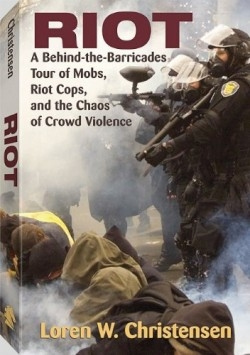Riot
A Behind-the-Barricades Tour of Mobs, Riot Cops, and the Chaos of Crowd Violence
Riots are frightening, fascinating, and shockingly widespread—capital material for the evening news. They can stem from almost anything, from political conventions to concerts, sporting events, jury verdicts, traffic accidents, or defamatory cartoons. If pressed, most of us can think of at least a few riots off the top of our heads: Kent State, Tiananmen Square, WTO, Watts, or the aftermath of the Rodney King incident.
Christensen takes us beyond the headlines to examine the subject up close and personal. He not only provides insight into the phenomena that can spark a riot, but also interviews participants from both sides of the law. Having worked stadium security during several sports riots and brushed up against both the Seattle WTO and Mardi Gras rampages, this reviewer can categorically state that Christensen’s portrayals are authentic, unbiased, and unwavering. Let’s face it, mobs are dangerous. Highly emotional and impulsive, they often erupt violently. Crowds can turn into mobs if members become indifferent to laws, choose to disregard authority, or take advantage of the perceived anonymity that a large group can provide and follow instigators into violent acts.
The author shows how five psychological influences—impersonality, anonymity, suggestion/imitation, emotional contagion, and discharge of repressed emotions—affect rioters, their targets, witnesses, and police officers who try to break things up. Fortunately these influences don’t impact everyone. Unfortunately the minority who are affected can cause serious confusion, destruction and injury for everyone else. Because riots can be hard to predict and even harder to stop, it is prudent to pay careful attention to what is going on around us whenever we are part of a crowd. Even if we do sense the mood change, catch a glimpse of the opening acts, and anticipate what’s coming, however, it can be very hard to force our way through the press of bodies and escape to safety.
This book truly helps readers identify danger signals and respond in a meaningful way. While law enforcement and security personnel will benefit from the information and insights, Riot is a terrific resource for everyday citizens as well.
Reviewed by
Lawrence Kane
Disclosure: This article is not an endorsement, but a review. The publisher of this book provided free copies of the book to have their book reviewed by a professional reviewer. No fee was paid by the publisher for this review. Foreword Reviews only recommends books that we love. Foreword Magazine, Inc. is disclosing this in accordance with the Federal Trade Commission’s 16 CFR, Part 255.

